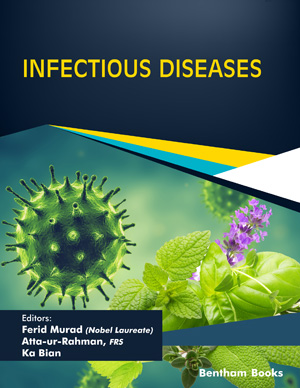Abstract
Atrial Fibrillation (AF) is the most common form of electrical disturbance of the heart and contributes to significant patient morbidity and mortality. With a better understanding of the mechanisms of atrial fibrillation and improvements in mapping and ablation technologies, ablation has become a preferred therapy for patients with symptomatic AF. Pulmonary Vein Isolation (PVI) is the cornerstone for AF ablation therapy, but particularly in patients with AF occurring for longer than 7 days (persistent AF), identifying clinically significant nonpulmonary vein targets and achieving durability of ablation lesions remains an important challenge.
Keywords: Atrial fibrillation, ablation, pulmonary vein isolation, cryoballoon, radiofrequency, left atrium.
Graphical Abstract
[http://dx.doi.org/10.1177/1747493019897870] [PMID: 31955707]
[http://dx.doi.org/10.1016/j.amjmed.2016.06.045] [PMID: 27476087]
[http://dx.doi.org/10.1056/NEJMoa1707855] [PMID: 29385358]
[http://dx.doi.org/10.15420/cfr.2018:3:1] [PMID: 29892474]
[http://dx.doi.org/10.1016/j.jacep.2015.05.005] [PMID: 29759361]
[http://dx.doi.org/10.1056/NEJM199809033391003] [PMID: 9725923]
[http://dx.doi.org/10.1093/europace/eur241] [PMID: 21791573]
[http://dx.doi.org/10.1161/CIRCULATIONAHA.108.825380] [PMID: 19188521]
[http://dx.doi.org/10.1111/j.1540-8167.2011.02178.x] [PMID: 21955090]
[http://dx.doi.org/10.1007/s10840-018-0425-0] [PMID: 30066291]
[http://dx.doi.org/10.15420/aer.2018.11.3] [PMID: 29967679]
[http://dx.doi.org/10.1161/CIRCEP.108.784272] [PMID: 19808412]
[http://dx.doi.org/10.15420/aer.2015.4.1.40] [PMID: 26835098]
[http://dx.doi.org/10.1161/CIRCEP.118.006576] [PMID: 30354288]
[http://dx.doi.org/10.1093/eurheartj/ehw210] [PMID: 27567408]
[http://dx.doi.org/10.1016/j.hrthm.2008.10.024] [PMID: 19121797]
[http://dx.doi.org/10.1161/CIRCULATIONAHA.108.772582] [PMID: 19029470]
[http://dx.doi.org/10.1001/jama.293.21.2634] [PMID: 15928285]
[http://dx.doi.org/10.1001/jama.2009.2029] [PMID: 20103757]
[http://dx.doi.org/10.1016/j.hrthm.2020.06.020] [PMID: 32590151]
[http://dx.doi.org/10.1016/j.hrthm.2017.01.003] [PMID: 28434446]
[http://dx.doi.org/10.1016/j.jacep.2018.07.007] [PMID: 30466850]
[http://dx.doi.org/10.1007/s40119-019-00158-2] [PMID: 31898209]
[http://dx.doi.org/10.1161/CIRCEP.114.001943] [PMID: 25528745]
[http://dx.doi.org/10.1111/jce.14311] [PMID: 31828883]
[http://dx.doi.org/10.1016/j.hrthm.2017.02.030] [PMID: 28259694]
[http://dx.doi.org/10.1111/jce.13899] [PMID: 30834593]
[http://dx.doi.org/10.1111/jce.14509] [PMID: 32314843]
[http://dx.doi.org/10.15420/aer.2016:27:2] [PMID: 28116081]
[http://dx.doi.org/10.1111/j.1540-8167.2007.01089.x] [PMID: 18266669]
[http://dx.doi.org/10.1186/s12872-020-01685-w] [PMID: 32867695]
[http://dx.doi.org/10.1111/jce.12252] [PMID: 24020649]
[PMID: 27957119]
[http://dx.doi.org/10.1002/joa3.12085] [PMID: 30327695]
[http://dx.doi.org/10.1161/JAHA.119.015260] [PMID: 32654581]
[http://dx.doi.org/10.1016/j.jacc.2016.07.770] [PMID: 27788847]
[http://dx.doi.org/10.1016/j.hrthm.2015.10.023] [PMID: 26477712]
[http://dx.doi.org/10.1161/CIRCEP.111.964080] [PMID: 22042883]
[http://dx.doi.org/10.1111/jce.14638] [PMID: 32583488]
[http://dx.doi.org/10.1161/CIRCEP.115.003382] [PMID: 26857907]
[http://dx.doi.org/10.1016/j.suc.2009.06.001] [PMID: 19782848]
[http://dx.doi.org/10.1093/eurheartj/ehn302] [PMID: 18614522]
[http://dx.doi.org/10.1056/NEJMoa1408288] [PMID: 25946280]
[http://dx.doi.org/10.1016/j.jacep.2017.05.009] [PMID: 29759532]
[http://dx.doi.org/10.1093/europace/euw338] [PMID: 28039211]
[http://dx.doi.org/10.1007/s10554-017-1179-y] [PMID: 28593399]
[http://dx.doi.org/10.1161/CIRCEP.118.007005] [PMID: 31401853]
[http://dx.doi.org/10.1016/j.hrthm.2015.08.019] [PMID: 26277862]
[http://dx.doi.org/10.1016/j.hrthm.2018.05.014] [PMID: 30060879]
[http://dx.doi.org/10.1007/s10840-016-0124-7] [PMID: 26971331]
[http://dx.doi.org/10.1016/j.jacep.2019.08.021] [PMID: 31753429]
[http://dx.doi.org/10.1016/j.hfc.2015.08.014] [PMID: 26968663]
[http://dx.doi.org/10.1161/CIRCULATIONAHA.113.005421] [PMID: 25028391]
[http://dx.doi.org/10.1016/j.jacc.2012.05.022] [PMID: 22818076]
[http://dx.doi.org/10.1016/j.jacc.2017.01.014] [PMID: 28279292]
[http://dx.doi.org/10.1016/j.hrthm.2015.12.028] [PMID: 26706193]
[http://dx.doi.org/10.1016/j.ahj.2018.05.021] [PMID: 30144981]
[http://dx.doi.org/10.1016/j.jacep.2017.09.177] [PMID: 29387810]
[http://dx.doi.org/10.1111/anec.12527] [PMID: 29271538]
[http://dx.doi.org/10.1093/europace/euw168] [PMID: 28204452]
[http://dx.doi.org/10.1161/CIRCEP.119.007233] [PMID: 31242746]
[http://dx.doi.org/10.1111/jce.13742] [PMID: 30230079]
[http://dx.doi.org/10.1056/NEJMoa1602014] [PMID: 27042964]
[http://dx.doi.org/10.1161/CIRCULATIONAHA.119.042622] [PMID: 31630538]
[http://dx.doi.org/10.1093/europace/euz155] [PMID: 31199860]
[http://dx.doi.org/10.1111/jce.13372] [PMID: 29064127]
[http://dx.doi.org/10.1016/j.jacc.2015.09.088] [PMID: 26700836]
[http://dx.doi.org/10.4022/jafib.2131] [PMID: 31139302]
[http://dx.doi.org/10.1016/j.ccep.2019.05.009] [PMID: 31400873]
[http://dx.doi.org/10.1161/CIRCEP.119.007541] [PMID: 31826648]
[http://dx.doi.org/10.1111/jce.14646] [PMID: 32613693]
[http://dx.doi.org/10.1161/CIRCEP.117.005861] [PMID: 29700055]
[http://dx.doi.org/10.1016/j.jacc.2014.04.072] [PMID: 25125294]
[http://dx.doi.org/10.1161/CIRCULATIONAHA.114.014092] [PMID: 26260733]
[http://dx.doi.org/10.1016/j.hrthm.2017.10.010] [PMID: 29030237]
[http://dx.doi.org/10.1016/j.jacep.2020.04.024] [PMID: 32819531]
[http://dx.doi.org/10.1161/CIRCEP.119.007781] [PMID: 31826647]
[http://dx.doi.org/10.1016/j.jacep.2018.04.005] [PMID: 30139499]
[http://dx.doi.org/10.1016/j.jacep.2018.06.005] [PMID: 30139498]
[http://dx.doi.org/10.1016/j.jacc.2019.04.021] [PMID: 31085321]
[http://dx.doi.org/10.1016/j.jacc.2020.07.007] [PMID: 32854842]
[http://dx.doi.org/10.1161/CIRCEP.120.008718] [PMID: 32383391]
[http://dx.doi.org/10.1161/CIRCEP.120.008580] [PMID: 32372696]



















